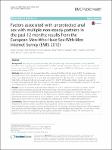Factors associated with unprotected anal sex with multiple non-steady partners in the past 12 months: results from the European Men-Who-Have-Sex-With-Men Internet Survey (EMIS 2010)
Kramer, Sarah C.
Schmidt, Axel J.
Berg, Rigmor C.
Furegato, Martina
Hospers, Harm
Folch, Cinta
Marcus, Ulrich
Background: Practising unprotected anal intercourse (UAI) with high numbers of partners is associated with increased risk for acquiring and transmitting HIV and other sexually transmitted infections. Our aim was to describe factors associated with UAI with multiple partners in a large sample of MSM from 38 European countries recruited for an online survey in 2010. Methods: Data are from the European Men-Who-Have-Sex-With-Men Internet Survey (EMIS). The analysis was restricted to men who reported any anal sex with a non-steady partner in the past 12 months, and who were either never diagnosed with HIV, or who had been diagnosed with HIV more than 12 months ago, reported a detectable viral load and did not exclusively serosort (n = 91,477). Multivariable logistic regression was used to compare men reporting UAI with four or more (4+) non-steady partners to two comparison groups: a) no UAI with non-steady partners, and b) UAI with 1-3 non-steady partners. Results: Overall, 9.6 % of the study population reported UAI with 4+ partners in the past 12 months. In both models, factors consistently associated with this behaviour were: having been diagnosed with HIV, lower educational levels, use of nitrite inhalants, drugs associated with sex and parties, or erectile dysfunction drugs in the past 4 weeks, using sex-on-site venues in the past 4 weeks, buying or selling sex in the past 12 months, having experienced physical violence due to sexual attraction to men in the past 12 months, reporting sexual happiness, being out to all or almost all of one’s acquaintances, and knowing that ART reduces HIV transmissibility. Conclusions: Effective antiretroviral treatment drastically reduces HIV transmission for men diagnosed with HIV, irrespective of partner numbers. Apart from reducing partner numbers or increasing condom use no other recommendations are currently in place to reduce the risk of HIV acquisition and onward transmission for HIV-negative men practicing UAI with multiple partners. A range of factors were identified as associated with UAI with four or more partners which allow the strengthening and targeting of prevention strategies to reduce HIV transmission risks resulting from condomless anal intercourse with multiple partners.
Dateien zu dieser Publikation
Keine Lizenzangabe
Verwandte Publikationen
Anzeige der Publikationen mit ähnlichem Titel, Autor, Urheber und Thema.
-
2007-05-20ZeitschriftenartikelDer Kinder- und Jugendgesundheitssurvey (KiGGS): Datenmanagement Dölle, Rüdiger; Rosario, Angelika Schaffrath; Stolzenberg, HeribertIm Rahmen des Kinder- und Jugendgesundheitssurveys (KiGGS) wurden erstmals umfassend und bundesweit repräsentative Daten zum Gesundheitszustand von Kindern und Jugendlichen in Deutschland erhoben. Im Laufe der 3-jährigen ...
-
2007-05-20ZeitschriftenartikelInanspruchnahme medizinischer Leistungen : Ergebnisse des Kinder- und Jugendgesundheitssurveys (KiGGS) Kamtsiuris, Panagiotis; Bergmann, Eckardt; Rattay, Petra; Schlaud, MartinInanspruchnahmen von Kinderfrüherkennungsuntersuchungen und niedergelassenen Ärzten sowie Operationen stellen eine Auswahl unterschiedlicher Leistungsbereiche aus dem Gesamtspektrum präventiver und therapeutischer Leistungen ...
-
2007-05-20ZeitschriftenartikelArzneimittelanwendung bei Kindern und Jugendlichen : Erfassung und erste Ergebnisse beim Kinder- und Jugendgesundheitssurvey (KiGGS) Knopf, HildtraudIm Kinder- und Jugendgesundheitssurvey (KiGGS) wurde die aktuelle Arzneimittelanwendung in den letzten 7 Tagen vor der Untersuchung bei 17.450 Studienteilnehmern im Alter von 0–17 Jahren durch ein standardisiertes ärztliches ...

